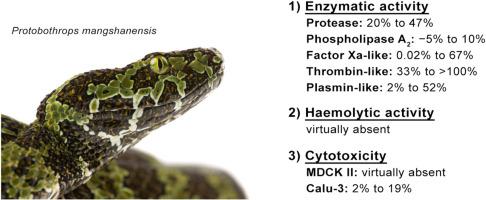In vitro assessment of enzymatic activities, haemolytic potential, and cytotoxic effects of Mangshan pit viper (Protobothrops mangshanensis) venom
IF 2.4
4区 医学
Q2 PHARMACOLOGY & PHARMACY
引用次数: 0
Abstract
The Mangshan pit viper (Protobothrops mangshanensis) is a medically relevant venomous snake endemic to China. Owing to its popularity in the pet trade, an increasing number of envenomations by this species have been reported, typically presenting with localised cytotoxicity and severe coagulopathy. However, the functional properties of P. mangshanensis venom have yet to be comprehensively characterised. In this study, we conducted an in-depth analysis of its biochemical activities using a broad panel of in vitro assays. We evaluated protease, phospholipase A2, Factor Xa-like, thrombin-like, and plasmin-like activities, alongside assessments of haemolytic and cytotoxic effects. The venom exhibited pronounced Factor Xa-like, thrombin-like, and plasmin-like activities (maximum 66.7 %, 112.1 %, and 51.9 %, respectively), but moderate protease activity (maximum 46.7 %) and low phospholipase A2 activity (maximum 9.9 %). In contrast, haemolytic activity was virtually absent. Cytotoxicity was assessed in two epithelial cell lines, MDCK II and Calu-3, with a response observed only in Calu-3 cells, which remained low (<19 %). Overall, our findings are consistent with the severe haemotoxicity reported following envenomation by the Mangshan pit viper, and highlight the venom's disruptive effects on the blood coagulation cascade. This characterisation enhances our understanding of the functioning of P. mangshanensis venom, and may support the development of more effective treatment for envenomation by this species.

芒山蝮蛇毒液的酶活性、溶血潜能和细胞毒作用的体外评价。
芒山坑蛇(Protobothrops mangshanensis)是中国特有的一种与医学相关的毒蛇。由于其在宠物贸易中的流行,越来越多的报道了这种物种的毒害,通常表现为局部细胞毒性和严重的凝血功能障碍。然而,芒山蛇毒液的功能特性尚未得到全面的研究。在这项研究中,我们进行了深入的生化活性分析,使用广泛的面板体外分析。我们评估了蛋白酶、磷脂酶A2、类xa因子、类凝血酶和类纤溶酶活性,同时评估了溶血和细胞毒性作用。该毒液表现出明显的类xa因子、类凝血酶和类纤溶酶活性(最高分别为66.7%、112.1%和51.9%),但蛋白酶活性中等(最高为46.7%),磷脂酶A2活性较低(最高为9.9%)。相反,溶血活动几乎不存在。在两种上皮细胞系MDCK II和Calu-3中评估了细胞毒性,仅在Calu-3细胞中观察到反应,其反应仍然很低(< 19%)。总的来说,我们的研究结果与报道的芒山蝮蛇中毒后的严重血液毒性一致,并强调了毒液对血液凝固级联的破坏性作用。这一特征增强了我们对芒山参毒液功能的认识,并可能支持开发更有效的治疗芒山参毒素的方法。
本文章由计算机程序翻译,如有差异,请以英文原文为准。
求助全文
约1分钟内获得全文
求助全文
来源期刊

Toxicon
医学-毒理学
CiteScore
4.80
自引率
10.70%
发文量
358
审稿时长
68 days
期刊介绍:
Toxicon has an open access mirror Toxicon: X, sharing the same aims and scope, editorial team, submission system and rigorous peer review. An introductory offer Toxicon: X - full waiver of the Open Access fee.
Toxicon''s "aims and scope" are to publish:
-articles containing the results of original research on problems related to toxins derived from animals, plants and microorganisms
-papers on novel findings related to the chemical, pharmacological, toxicological, and immunological properties of natural toxins
-molecular biological studies of toxins and other genes from poisonous and venomous organisms that advance understanding of the role or function of toxins
-clinical observations on poisoning and envenoming where a new therapeutic principle has been proposed or a decidedly superior clinical result has been obtained.
-material on the use of toxins as tools in studying biological processes and material on subjects related to venom and antivenom problems.
-articles on the translational application of toxins, for example as drugs and insecticides
-epidemiological studies on envenoming or poisoning, so long as they highlight a previously unrecognised medical problem or provide insight into the prevention or medical treatment of envenoming or poisoning. Retrospective surveys of hospital records, especially those lacking species identification, will not be considered for publication. Properly designed prospective community-based surveys are strongly encouraged.
-articles describing well-known activities of venoms, such as antibacterial, anticancer, and analgesic activities of arachnid venoms, without any attempt to define the mechanism of action or purify the active component, will not be considered for publication in Toxicon.
-review articles on problems related to toxinology.
To encourage the exchange of ideas, sections of the journal may be devoted to Short Communications, Letters to the Editor and activities of the affiliated societies.
 求助内容:
求助内容: 应助结果提醒方式:
应助结果提醒方式:


